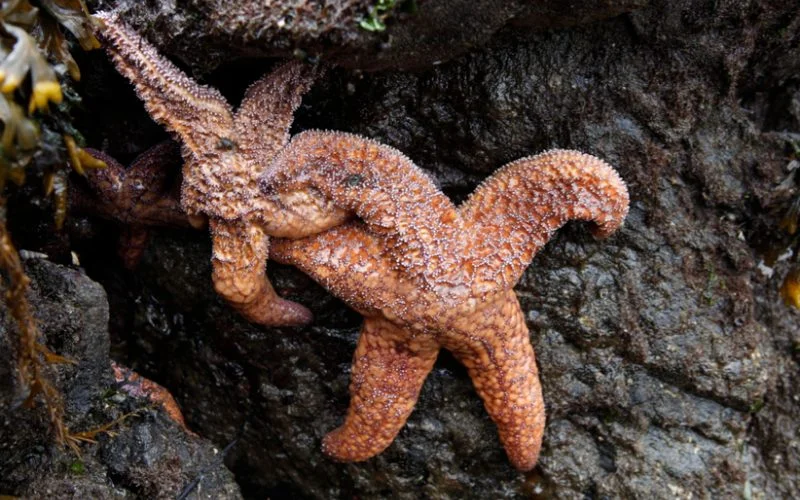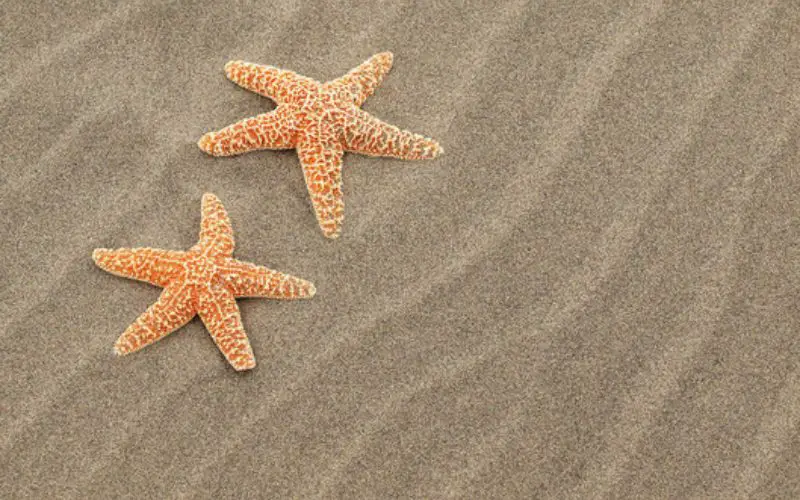Starfish are some of the fascinating marine invertebrates found in the world’s oceans; little wonder there are even television shows for kids about these creatures – Sponge Bob Square Pant and the Patrick Star show. Many people need to understand more about these beings, like what they eat, if they live on rocks and other questions.
Some starfish species live in rocks, but most times, stars attach themselves to rocks; it’s simply a strategy to escape from the glare of a predator or simply lurking in disguise, waiting for unsuspecting prey. Today we will learn more about starfish, where they live, and how they survive.
About Starfish
Starfish, which are also called sea stars, are star-shaped echinoderms that are found in all the oceans of the world – from the intertidal zone down to abyssal depths, at about 20,000 ft or 6,000 m below the surface, but they can also be seen in shallow water. There are over 1900 species of starfish.
Starfish are marine animals that have no skeleton. Even though some species have more arms, they have central and five arms. The upper surface of their bodies is usually smooth, spiny, and granular and covered with overlapping plates. They come in different bright colors in various shades, including red, orange, blue, grey, or brown.
Starfish feed on other invertebrates that live at the bottom of the ocean, where their specialized feeding method of eversion of their stomachs and suspension feeding keeps them living. They are very complex animals that reproduce asexually and asexually, depending on the situation.
Some of the most common starfish species include:
- Ochre sea star (Pisaster ochraceus)
- Reef sea star (Stichaster australis)
- Crown-of-thorns starfish (Acanthaster planci)
- The Northern Pacific seastar
Some Fascinating Facts About Starfish

Starfish are captivating little creatures because of their unique shape and looks and other surprising attributes of these sea animals. Here are some such interesting facts about sea beings:
They Are Not Fish
The irony is that starfish are not linked to fish; they belong to a class of invertebrates like sea urchins, cucumbers, and sand dollars. Many Marine biologists tried to change the starfish’s common name with the correct name, but they are still widely called starfish.
Starfish Have No Blood Nor Brain
Starfish don’t have blood or a brain, but they have a complex and highly developed nervous system that runs around the mouth and arms.
So, they get the nutrient from the sea by filtering seas water to pump nutrients through their nervous system instead. Even though they have no brains, it doesn’t mean they are dumb.
Starfish are relatively Heavy.
Looking at the fragile frame of the starfish, you will never think they weigh as much as they do. There are starfish that weigh as much as 15 pounds.
Starfish Have Longevity
Starfish live pretty long; the bigger they are, the more their longevity. Starfish can live as long as 35 years.
Starfish Have Many Species
There are 1900 species of starfish and still counting, found in different aquatic climates, be they warm or cold, from our local waters to the Indian and Pacific Oceans.
Some Starfish Have More Than five arms.
If you think the five arms of the most common starfish are impressive, wait until you see some starfish species’ very impressive 40 arms. Their arms are covered with pincer-like organs, which help the sea stars to move slowly on the sea floor.
Starfish Do Not Survive In Fresh Water
Even though starfish can live in many different aquatic environments, it doesn’t mean they can survive in freshwater. They only live in saltwater oceans.
Starfish Limbs Do Regenerate
There are times that starfish lose a limb, maybe to predators; when this happens, they do not fret because they can grow a replacement limb all alone. It may take a while.
Starfish Turn Themselves Inside Out To Eat
Starfish feed on shells, mussels, clams, shells, and mussels. When they get their prey, they have small suction cups, which they use to take hold of their food. As they eat, their stomach leaves their mouths to digest the food and re-enters the body after eating.
Starfish Have Eyes
Yes, starfish have eyes or more like eyespots, but these are on the tips of the arms. Many people thought that starfish couldn’t possibly see due to the absence of a brain, but studies proved that they see rough images. The eyespots are essential to help them navigate and also find food.
Starfish Move Relatively Fast
Starfish have tiny tentacles or, more like, “tube feet” on the underside of their body, with which they can move up to 2 inches (0.5 cm) every second. The tube feet also help them to cling to rocks or corals.
Do Starfish Live Under Rocks?
The answer is YES. Some starfish live under the rocks, all to avoid predators. They can easily camouflage their way out, being devoured by their different predators, such as seagulls and sea otters of the ocean. Starfish also live under rocks lying in wait for their prey.
They also use their tiny tube feet to firmly attach themselves to the rocks so the ocean currents do not wash them away.
Here are Other Places Where Starfish live

Coral Reef
Starfish, as well as 25℅ of all marine species, also live in coral reefs, the most diverse underwater ecosystems in the world.
Coral reefs are formed by large colonies of coral polyps, which are kept together by calcium carbonate. Starfish find coral reefs a perfect home because of the abundance of food available there.
Starfish also find reefs a perfect home because their colorful skin acts perfectly as camouflage. Moreover, very bright-colored species can scare off or confuse their predators.
Unfortunately, a specie of starfish poses a threat to coral reefs because they are corallivores, so they feed on coral polyps. This specie of starfish is called “Crown-of-thorns starfish – the name is apt.
Tidal Pools
Some starfish live in tidal pools, which are isolated pockets of seawater formed in the ocean’s rocky or sandy intertidal zones (shallow seashores). These pools, whose depth varies significantly, are home to many other sea animals like snails, clams, sea urchins, crustaceans, seaweed, and small fish – all prey to the starfish.
To survive this harsh environment, starfish and other organisms often attach themselves very tightly to rocks so they’re not washed ashore. The most common starfish you find in tidal pools are Ochre Starfish.
Mud
Ctenodiscus Crispatus is a species of starfish living in mud. Little wonder the specie is called – a Mud Star. They live mainly on continental shelves worldwide, mostly in the Arctic Ocean and Subarctic cold water environments.
The Mud star eats and gets its nourishment from mud, and its body, too, is filled with mud. This starfish species has a high tolerance for hypoxia, a condition that occurs when oxygen is not in sufficient amounts for living things, and that is why it can survive in the mud where the oxygen supply is not ample. Other species of starfish that live in the mud are C. australis and C. procurator.
Sand
Some starfish species, like the sand dollars, burrow into and live in the sand, where they can search for food and hide from predators. Sand-sifting starfish is another starfish that can burrow into the sand. They sift through the sand and eat detritus’ leftover food particles. They are not easily spotted because of their color and the fact that they usually stay under the sand.
Kelp Forests
When dense growth of much different kelp specie is clumped together in the sea, they are called Kelp forests. These are underwater ecosystems in shallow water that look like plants but, in reality, are giant brown algae. They provide a unique habitat for many marine organisms like the starfish.
You find kelp forests in many parts of the globe, including the west coast of North and South America, Australia, New Zealand, southern Africa, the northern part of Japan, and the North Sea. The Sunflower starfish is one species common in many kelp forests, and it is an enormous starfish whose 16 to 24 arms each can be as long as a meter (3 feet).
Conclusion
Starfish are very captivating sea invertebrates found in almost all parts of the globe. These creatures, whose name is an irony because they are not fish, live under rocks to escape from predators or lurk in wait for prey.
Helpful Links
- How to Use a Chiminea for the First Time
- Why Use Lava Rock For fire Pit
- How to Fix a Bad Drywall Mud Job
- How to kill a Palm Tree
- What Do Goat Head Plant Look like
Starfish live in many different habits, including coral reefs, kelp forests, sand, and mud.
Do well to follow us on Facebook, Instagram, and Pinterest for more update and don’t forget to share on your social media accounts to get to those that will find this article valuable.

